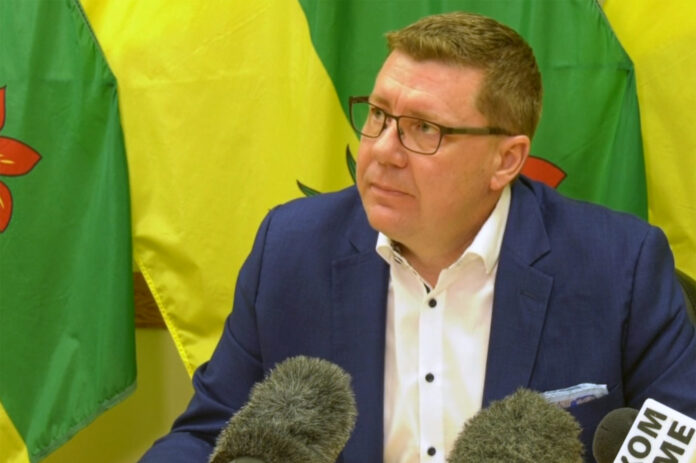The provincial government has extended Saskatchewan’s public health measures until March 19, and added more health care workers to the list of residents who qualify for the COVID-19 vaccine during the phase one rollout.
Premier Scott Moe said Saskatchewan’s COVID numbers have improved since the government implemented strict public health orders last year. However, both Moe and Chief Medical Health Officer Dr. Saqib Shahab said there is still some risk in spreading the disease, so the orders will remain in place.
“There is reason for optimism, but it’s not a reason for us to let our guard down,” Moe told reporters during a press conference on Tuesday. “What we are doing in Saskatchewan is working … but we need to keep doing it to ensure this trend continues for the foreseeable future.”
“Even though our case numbers are trending down, as the premier said, it is just our second week of our numbers consistently (being) below 200 (new cases per day), and we really need to sustain this course,” Shahab added. “We’re trending in the right direction, but we’ve seen how quickly that can reverse, not just in Saskatchewan, but in many other provinces.”
The public health orders were set to expire on Friday, but Shahab said the province needs to remain cautious until more healthcare workers can get vaccinated.
Moe said the province expects to receive around 28,000 doses of the Pfizer vaccine, along with 4,500 doses from Moderna. Those shipments will primarily be used for second doses. First doses will head to Swift Current and the rest of the southwest. The South West and South Central zones are the only two in the province that have not received any COVID vaccines.
“This is still a very low number of doses, but the federal government assures us that deliveries will be ramping up significantly into March, and then into the second quarter of this year,” Moe said. “I can tell you, it can’t happen soon enough.”
Saskatchewan has received fewer doses than originally intended, and that trend will likely continue. The majority of the next Moderna shipment will go to Canada’s northern territories, which means reduced shipments to the provinces. Public health officials in Nova Scotia, New Brunswick and Prince Edward Island have already said they expect to see fewer Moderna doses in February as a result.
Moe estimated Saskatchewan will only receive between 65 to 75 per cent of the vaccine doses they were told would arrive by the end of February. He declined to say whether diverting those vaccines to the territories was the right call, but said it would create additional challenges in Saskatchewan.
“What I’m saying is there are consequences,” he said. “We’re not sure how we’re going to navigate this at this point in time, but we’ll have 1,000 people, (who) it appears will be short of having access to their Moderna second doses. Maybe there’s 1,000 people who won’t show up for their second dose. I don’t know at this time.”
The province aimed to have residents receive their second dose within forty days, but Moe said that timeline may need to be extended. Shahab said that shouldn’t be a problem, since there’s a growing pile of evidence that the second dose will still be effective if delivered after 40 days.
The number of active COVID-19 cases numbers has dropped from a 2021 high of 4,265 on Jan. 18 to 1,611. However, Shahab said they’re still seeing large outbreaks in hospitals, long-term care homes and some workplaces. Until vaccination numbers increase, he said Saskatchewan residents need to stay vigilant and keep following the public health guidelines.
“This has always worked for us, (and) it will work for us again,” Shahab explained. “It’s really important to keep our numbers low so that vaccination clinics, as they start ramping up, can happen in a smooth manner (and) healthcare workers can give vaccinations instead of having to look after patients in hospital (or) do contract tracing.”
Province adds additional health care workers to phase one vaccine priority list
Up to 2,600 physicians and 1,200 pharmacists are now eligible for the COVID-19 vaccine after the provincial government increased the number of health care workers who qualified for phase one of the vaccination rollout.
Vaccination teams, hemodialysis, anesthesia and operating room staff, radiology technicians, home care workers, Phlebotomy and lab staff who handle COVID-19 specimens and other critical health care workers will also be eligible under the updated guidelines.
Moe said those health care workers are more likely to come in contact with COVID-19 patients, which puts them in greater danger of catching and spreading the virus.
“We did say last week that we would be reviewing about 16,000 healthcare workers who were originally allocated to go into phase one,” Moe told reporters. “This does preserve our ability to have a mass vaccination capacity, and really turn these vaccines around when we receive them in higher numbers.”
The move means an estimated 11,500 people have been added to the phase one priority sequencing list. There are now roughly 26,000 health care workers eligible in phase one, which makes up about 60 per cent of the province’s health care workforce.
Shahab said health care officials constantly review who is eligible for vaccination in phase one. He said getting a larger number of healthcare workers vaccinated would reduce the number who were not working because they were considered close contacts.


